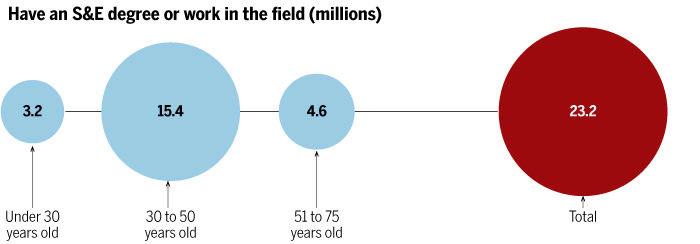March for Science: How many scientists and engineers will march?
Just how many marchers will show up at Saturday’s March for Science?
ScienceInsider’s crystal ball isn’t good enough to make that forecast (and local weather conditions are likely to play a big role in determining turnouts).
But with some help from statistics compiled by the National Science Foundation’s 2016 edition of Science and Engineering Indicators, we have been mulling another puzzle: If every scientist and engineer in the United States shows up at the U.S. marches, how many bodies would that be?
Turns out there are a few ways you can answer that question (and the following numbers are for 2013, the most recent year for which data are available). For example:
Everyone who holds an S&E degree
There are about 21.1 million people who have a bachelor’s or higher degree in a science or engineering (S&E) field (the big red circle, below). So, if every one of these degree-holders come, that could be a hefty turnout!
But what if just degree-holders in certain fields—such as the social or life sciences (the blue circles)—march?
Well, if social scientists turn out, that’s 6.4 million people.
But if only physical scientists show up, that’s just 1 million.
Counting by highest S&E degree
What if only those with an S&E Ph.D. march?
It turns out that, of those 21.1 million degree holders, about 15.8 million hold their highest degree in an S&E field. (In other words, they didn’t switch to law, business, or some other field.)
March organizers wouldn’t want just doctorate holders to show up, however: That’s just 1 million people, less than 10% of the 11.4 million people holding a bachelor’s degree in S&E.
Just college-educated S&E workers
There is another way to slice the U.S. S&E workforce that dramatically shrinks the pool of potential marchers.
What if only college graduates employed in an S&E occupation march?
That’s just 5.7 million people.
Even if those in the largest occupational field—computer and math—show up, that would be just 2.6 million people.
If only those with physical science jobs march? A paltry 319,000.
By age or workplace
What if your age determines whether you will march? Say that being under 30 makes you more willing to spend a Saturday pounding the pavement.
Or that who you work for—industry, an educational institution, or government—determines your likelihood of marching?
To explore those scenarios, we combined two groups: those who have any kind of S&E degree, and those who may not have a degree but work in an S&E-related occupation. That is a pool of about 23.2 million people.
Younger folks might be more enthusiastic about marches, but there aren’t many of them in this group: just 3.2 million. So organizers might want the march to skew middle-aged.
Just foreign-born or female S&E workers
Here are two final ways of looking at the numbers.
What if just foreign-born individuals working in an S&E occupation march?
Or just women in those fields?
Although the numbers vary somewhat depending on the source, there are about 6.25 million people employed in S&E occupations (including those without a college degree). About 27% are foreign-born, and 29% are women.
So a native-born, male crowd might boost turnout—but might not do much to demonstrate diversity.







Comments are closed, but trackbacks and pingbacks are open.